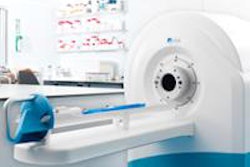A campaign by the Ontario Ministry of Health to reduce inappropriate referrals for lumbar MRI resulted in more-appropriate exams, but it did not lower the number of new referrals, according to a study published in the August issue of the Journal of the American College of Radiology.
After policy changes were implemented, including the distribution of appropriateness guidelines and the creation of an online clinical decision-support tool for referring physicians, the number of inappropriate lumbar MRI referrals dropped from 48% to 37%.
However, there was no significant difference in the number of new lumbar MRI referrals before (246 per month) and after (233 per month) the policy went into effect (JACR, August 2014, Vol. 11:8, pp. 802-807).
More studies are needed to clarify the effects of the campaign, and other interventions will most likely be required to fully improve appropriateness of the exams, according to lead author and medical student Sean A. Kennedy, from McMaster University, and colleagues.
"We hope that the results of this study specifically highlight the role radiologists can play in improving the appropriateness of imaging referrals," they wrote. "Working as an integrated unit with referring physicians, radiologists should serve as the gatekeepers to medical imaging resources."
History of overutilization
The overuse of MRI to diagnose back problems is not a new concern. Previous studies have linked inappropriate referrals with a lack of knowledge, as well as patient demand and the practice of defensive medicine, the authors wrote.
Kennedy and colleagues did note that Canada fares better than most developed countries in the use of MRI per capita. One study found that in 2011 and 2012, 49 MRI scans per 1,000 people were performed in Canada; by comparison, the U.S. rate was 98 MRI exams per 1,000 and Germany's rate was 95 MRI scans per 1,000.
Still, "lumbar MRI studies for low back pain are a heavy burden on the Canadian healthcare system," they wrote.
In May 2012, the Ontario Ministry of Health launched its campaign intended to curb overutilization of lumbar MRI, with efforts such as changing the wording of billing codes, distributing appropriateness guidelines to physicians, and developing a decision-support tool, according to the researchers. Their retrospective analysis reviewed lumbar MRI referral forms from before and after the campaign.
A total of 600 lumbar MRI referrals -- 300 before and 300 after the policy changes -- were randomly selected for the study. The number of new referrals during three-month periods before and after policy implementation was also counted.
The prepolicy-change group included patients referred from January 1, 2012, through March 31, 2012. This cohort contained 151 women (53%) and 133 men (47%), who had a mean age of 52.3 years (± 16.4 years).
After the policy changes went into effect, Kennedy and colleagues paused data collection for a three-month grace period, beginning May 2012. "We felt that this was appropriate given that the wait time from referral to lumbar MRI at our center is < 69 days for nine in 10 patients," they wrote.
For the postpolicy-change period, the researchers selected three months between August 1, 2012, and September 30, 2013. This group included 163 women (55%) and 131 men (45%), who had a mean age of 53.7 years (± 18.4 years).
Exam appropriateness
To assess the referrals, the researchers used American College of Radiology (ACR) Appropriateness Criteria for low back pain imaging. The criteria include six clinical factors for lumbar MRI referrals and a rating from 1 to 9 -- the higher the score, the more appropriate the referral.
Before the policy changes went into effect, 50.4% of the referrals were appropriate, compared with 62.6% after the changes, Kennedy and colleagues found. Prior to the initiative, inappropriate referrals were 47.9%, compared with 37.1% after the changes.
| Appropriateness of lumbar MRI referrals | ||
| Before policy changes | After policy changes | |
| Not appropriate | 47.9% | 37.1% |
| May be appropriate | 1.8% | 0.3% |
| Appropriate | 50.4% | 62.6% |
The mean appropriateness score increased significantly after the policy changes, shifting from 5.08 to 5.79 (p = 0.004).
There was no significant difference, however, in the number of new lumbar MRI referrals before (246 ± 20.1 per month) and after (232.7 ± 38.3 per month) the policy changes (p > 0.05).
The somewhat contradictory results of improved appropriateness but the same level of new referrals led the authors "to question whether the appropriateness increase is in fact genuine," they wrote.
"We could speculate that referring physicians may be using certain key words (e.g., references to a 'chronic' timeline of pain symptoms) to artificially increase the appropriateness of their referrals," they added.
Overall, the results are comparable to existing published data, which show that 28% to 100% of lumbar MRI studies for low back pain in the U.S. are "inappropriate or medically unnecessary," Kennedy and colleagues noted.
Radiologists' role
"Investing in evidence-based infrastructure such as mandated point-of-care decision-support referral forms will likely improve the appropriateness of imaging in Canada without sacrificing high-quality patient care," they concluded. "Designing these point-of-care decision supports should involve radiologists who can use their expertise to rigidly implement best-practice guidelines."
The authors also credited radiologists as the most likely to be informed about appropriateness criteria; therefore, radiologists are "in the best position to make decisions on whether tests should or should not be performed."
They cited several limitations of the study, including the lack of a validated method to evaluate referrals, as well as a lack of referrals for surgical planning.


.fFmgij6Hin.png?auto=compress%2Cformat&fit=crop&h=100&q=70&w=100)





.fFmgij6Hin.png?auto=compress%2Cformat&fit=crop&h=167&q=70&w=250)











